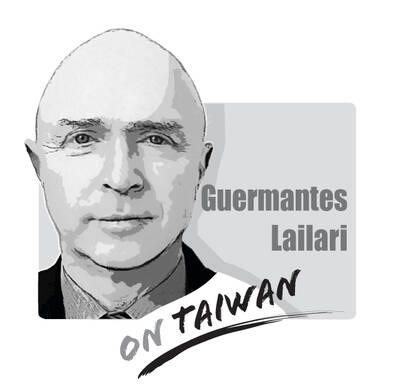Taiwan finds itself in a period of transitional justice. Taiwanese, determined to make social dialogue a reality, are facing challenges with courage and hope.
An article on Monday last week titled “Taiwan’s hopes for transitional justice” by Academia Sinica research fellow Wu Nai-teh (吳乃德) in the Chinese-language Liberty Times (the Taipei Times’ sister newspaper) made a big impact as it pointed out several ways to create social dialogue.
The best place for implementing these ideas is the museum at the Chiang Kai-shek Memorial Hall.
During President Tsai Ing-wen’s (蔡英文) first term in office, the Ministry of Culture ran a memorial hall review and art transformation project, but the project did not generate enough ideas.
The media reported that many programs remained unannounced, stuck in the Executive Yuan, Whether they were not announced following passionate decisions over political name rectification in 2007 and 2008 will never be known.
During the first name rectification campaign in 2007, almost 100 White Terror and 228 Incident victims and family members stepped into the Chiang Kai-shek Memorial Hall for the first time in their lives to express their support for changing the name to National Taiwan Democracy Memorial Hall.
It is difficult to imagine what they felt as they did so.
In 2008, then-president Ma Ying-jeou (馬英九) undid the name change and proposed an exhibition that would show Chiang’s mistakes as well as his achievements, something he never followed through on during his eight years in office.
Wu’s article brought up the complicated issue of whether the memorial hall should be kept.
Before politicians make a decision, he wrote, it would build mutual understanding to use the memorial hall as a museum in which people could talk about the nation’s contested history, as was intended by the theme for International Museum Day in 2017: “Museums and Contested Histories: Saying the Unspeakable in Museums.”
The theme for this year’s International Museum Day is “Museums for Equality: Diversity and Inclusion.”
Perhaps this could offer Taiwanese society an opportunity to collectively gain a deeper understanding of difficulties encountered and achievements gained in transitional justice experiences in Germany and South Africa, as well as countries in eastern Europe, South America and Asia.
Using the memorial hall space to host comparative exhibitions, films, symposiums and other activities addressing transitional justice in Taiwan and abroad, while also collecting and publishing visitors’ opinions would be a transparent and creative way to gauge public opinion and build mutual trust, while respecting democracy and freedom.
The Chiang Kai-shek Memorial Hall, the National Human Rights Museum, the National 228 Memorial Museum and the Transitional Justice Commission should work together with private museums to gain an understanding of what most members of the public are thinking.
Using the museum in this way would have the lowest social cost, while offering the best opportunity for dialogue and making use of soft power.
It is also a precious and unique opportunity gifted to Taiwanese by their forbears’ sacrifice and struggle, which built the freedom that Taiwan enjoys today. It is an opportunity for all of Taiwan to show the world how it implements transitional justice.
Tsao Chin-jung is president of Taiwan Art-in Design.
Translated by Perry Svensson

Chinese state-owned companies COSCO Shipping Corporation and China Merchants have a 30 percent stake in Kaohsiung Port’s Kao Ming Container Terminal (Terminal No. 6) and COSCO leases Berths 65 and 66. It is extremely dangerous to allow Chinese companies or state-owned companies to operate critical infrastructure. Deterrence theorists are familiar with the concepts of deterrence “by punishment” and “by denial.” Deterrence by punishment threatens an aggressor with prohibitive costs (like retaliation or sanctions) that outweigh the benefits of their action, while deterrence by denial aims to make an attack so difficult that it becomes pointless. Elbridge Colby, currently serving as the Under
The Ministry of the Interior on Thursday last week said it ordered Internet service providers to block access to Chinese social media platform Xiaohongshu (小紅書, also known as RedNote in English) for a year, citing security risks and more than 1,700 alleged fraud cases on the platform since last year. The order took effect immediately, abruptly affecting more than 3 million users in Taiwan, and sparked discussions among politicians, online influencers and the public. The platform is often described as China’s version of Instagram or Pinterest, combining visual social media with e-commerce, and its users are predominantly young urban women,
Most Hong Kongers ignored the elections for its Legislative Council (LegCo) in 2021 and did so once again on Sunday. Unlike in 2021, moderate democrats who pledged their allegiance to Beijing were absent from the ballots this year. The electoral system overhaul is apparent revenge by Beijing for the democracy movement. On Sunday, the Hong Kong “patriots-only” election of the LegCo had a record-low turnout in the five geographical constituencies, with only 1.3 million people casting their ballots on the only seats that most Hong Kongers are eligible to vote for. Blank and invalid votes were up 50 percent from the previous
Japanese Prime Minister Sanae Takaichi lit a fuse the moment she declared that trouble for Taiwan means trouble for Japan. Beijing roared, Tokyo braced and like a plot twist nobody expected that early in the story, US President Donald Trump suddenly picked up the phone to talk to her. For a man who normally prefers to keep Asia guessing, the move itself was striking. What followed was even more intriguing. No one outside the room knows the exact phrasing, the tone or the diplomatic eyebrow raises exchanged, but the broad takeaway circulating among people familiar with the call was this: Trump did